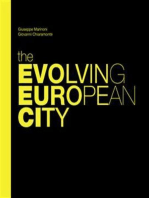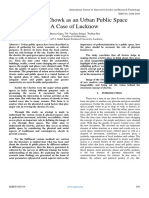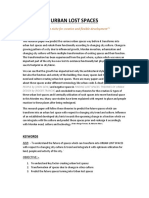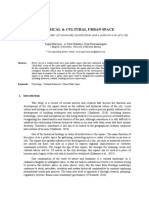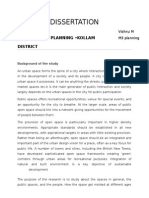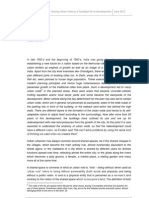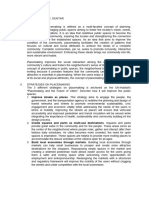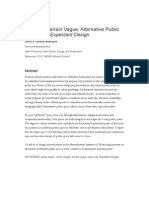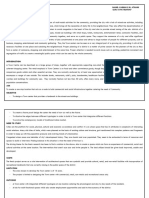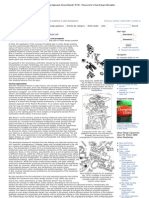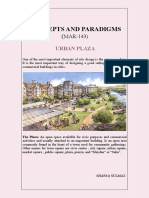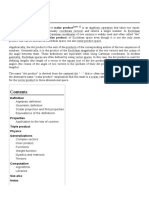Professional Documents
Culture Documents
Symbolic Interaksionisme A Social Reality in An Architectural Public A Transformation of Space
Original Title
Copyright
Available Formats
Share this document
Did you find this document useful?
Is this content inappropriate?
Report this DocumentCopyright:
Available Formats
Symbolic Interaksionisme A Social Reality in An Architectural Public A Transformation of Space
Copyright:
Available Formats
Volume 7, Issue 9, September – 2022 International Journal of Innovative Science and Research Technology
ISSN No:-2456-2165
Symbolic Interaksionisme a Social Reality in an
Architectural Public a Transformation of Space
Hidayat Marmin
Teaching Staff of the Faculty of Architecture
Department. Engineering, Pepabri Makassar University, Indonesia
Arfenti Amir
Megarezky, University Lecturer
Abstract:- This article is a research record on the had not yet appeared, shopping centers really only served as
ongoing transformation of the public sphere in places to transact economic trade, airports were only limited
Indonesia. Where the characteristics and behaviors of to places to raise or drop off airplane passengers, hotels only
users of the public sphere experience dialectics, the cause as places to stay. The trading center in Makassar City was
is the hegemony of a capitalist group's domination over originally only centered around Karebosi, Central Market,
another (dominated) group by means of incorporating and Entertainer Street, which later experienced polarization
dictated idealism, then accepted as something natural. and brought about spatial physical changes in urban space
For example, the 'indoctrination of architectural design' caused by the impetus of capitalism to change the structure
which causes the commodification of public space, raises of urban space from means of production to reproduction of
a new awareness for users of public space and urban space. Then this change was very pronounced in the
unconsciously they raise their status to the middle class, postmodern era, namely when the penetration of capitalism
follow popular culture, and imitate the behavior or penetrated market places, then everything experienced the
lifestyle of the bourgeois class. These are all illusions that dynamics of movement, including the dynamics of change
capitalists deliberately create so that the characteristics in the public sphere as a marker of a transformation.
of the dominated people lose their ideology and identity
as free individuals. Public space becomes a new means of Karebosi Square is one of the famous squares in
accommodating all those desires, so it is difficult to avoid Indonesia and is a public space that has existed since
how then public space transforms, and no longer colonial times. Karebosi was once known as Koningsplein
becomes a social space that is free to be accessed by the and has its main function as a green open space located in
public at no cost. the center of Makassar. As the heart of the city, Karebosi
has more than just a green open space, but also has social,
Keywords:- Transformation, Capitalist Hegemony; economic and ecological functions, and even cultural and
Commudification of public spaces; Social space. historical functions.
I. INTRODUCTION In October 2007 the Karebosi field underwent a
revitalization aimed at optimizing public spaces in
The impact of globalization has dramatically affected downtown Makassar, with the main function as a sports
the lives of millions of people around the world and resulted park, green open space and supporting functions as a
in a transformation, caused by the spread of practices, parking area (cluster parking) and shopping space
relationships, awareness, and organizing in almost all (commercial space). After undergoing revitalization,
corners of the world. And mobility becomes a differentiating Karebosi is no longer solely an open space place where
factor in social stratification. In Indonesia, this process of many people use it to carry out sports activities, hold music
globalization began to be felt from the beginning of the start concerts and the like, which usually the general public can
of development mobility in various metropolitan cities access and share with each other within the area at no cost.
during the New Order period. However, the field, which is able to accommodate up to
hundreds of thousands of people, is currently undergoing a
The movement of urban space has brought changes to change in function, apart from being an open space, it is also
a context of transformation on the scale of public space, a business (commercial) land. Although the upper part is
which in fact is to start from a conception of the public still in the form of a field, the underground mall building
domain as a democratic space. But in reality the public with an access road in the form of a tunnel that penetrates
space is no longer purely a place where all audiences meet into the Mtc Karebosi mall has become part of the Karebosi
freely and belong to everyone. This is a phenomenon that is Field area.
the link of the rapid and revolutionary movement of urban
space change. Then Panakukang mall which is also currently the most
popular shopping center in the city of Makassar and is one
This culture of change globally has also resulted in the part of the pole of business growth in the Panakukang
growth of Market Places in shopping centers, airports, business district.
hotels, etc. And bring a very strong influence in the
hegemony of the transformation of public spaces in various
metropolitan cities in Indonesia. In the 70s this symptom
IJISRT22SEP387 www.ijisrt.com 548
Volume 7, Issue 9, September – 2022 International Journal of Innovative Science and Research Technology
ISSN No:-2456-2165
The dialectic of shifting meaning to changes in the III. RESULT AND DISCUSSION
functions of open space in the Panakukang area began with
the construction of a residential area by the developer PT. A. Social Space in architectural design paradigms
Asindo, then experienced development as a Market Place George Simmel (1858-1918) was one of the first figures
area with the presence of several shophouse buildings and to put forward his thoughts on the “social space”. At least
the Panakukang Mall shopping center which brought a very two of Simmel's constructs on social space were published
strong influence in the hegemony of transforming public in 1903, namely 'the Sociology of Space' and 'on the Spatial
spaces in Makassar. At first, the developer only prepared Projections of social Forms'. Later in 1908, Simmel revisited
housing accompanied by environmental facilities in the form and expanded the article into a book Soziologie, adding
of open spaces in several places. Capitalist penetration then three important essays namely "The social Boundary', 'the
brought the consequences of very rapid change, turning the Sociology of the Senses' and 'The Stranger’ (Fearon, 2007).
Panakukang area into the most lucrative business surfshop
in the city of Makassar, and of course resulting in several Here Simmel does not merely present a theory of
public space zones in the Panakukan area undergoing a social space in an organized manner, but he only links
change in shape or undergoing a process of transformation. between concepts, contexts and examples of orientation
according to history, which is to provide a heuristic ‘tool’
Public spaces that were previously public domain are for approaches to the sociology of social space. It
now of commercial significance. At first, although it was concentrates on five basic frames of space construction;
still needed by the public at a very limited need but now First, the exclusivity of space, truly no two bodies can
there is a new meaning, the tendency of people to be more occupy on the same space. The social space is constructed
interested in utilizing public spaces (central place) such as by being and exclusivity, which the group occupies. Second,
this Panakkukang Mall as a medium where to interact, Space is a subdivision for social purposes and is framed
because the public needs entertainment, although in within boundaries. Thirdly, the concentration or mixing of
principle they come there for commercial purposes. This social interactions in space also affects social formation.
shift occurred after something experienced by the Fourth, all social interactions can be characterized by a
community that he did not find in the context of public degree of closeness between individuals and groups. Fifth,
spaces in general, but was created in new means of shopping the special relationship in a group but has undergone a
places such as Panakukang mall. change of location, such as the community of a tribe but has
moved to another place. Simmel's writing of” the Stranger
The above explanation reminds us that there has "is an example, where"the distance of a relationship is
actually been a symbolic change and there is a tendency to determined not only by the condition of the relationship
change the interpretation of individual social behavior in the between people, but also by the symbols in the relationship".
public sphere. Humans as actors who respond to physical
objects (objects that form a symbol), as well as social In the philosophy of architectural design, the word
objects (in the form of individual actions that describe a ‘space’ always refers to two properties, namely; architecture
behavior). The theory of symbolic interaction explains how means space mathematically that is objective and
the relationship between symbols and interactions arises, quantitative, in a physical entity and object bounded by
when a problem arises about the need for public space, then three axes: x, y, and z. Psychologically architecture defines
in fact at that time the determinant of symbols will not only space as the locus of mixing, meeting, or even fighting
answer a "number dimension" of length, width, height, area, various human needs and wants that are subjective and
etc. but more than a symbol of social dimensions that can qualitative. Architecture was originally more about the
affect the meaning that may be different in each actor. concept of how we construct space (construction of space)
related to the physical aspect and also the philosophical
II. RESEARCH METODS conception of space, but then Henri Lefebvre the French
sociologist neo-Marxist make another very essential
The method used in this study is a qualitative approach, namely by questioning how the physical and
descriptive method, where the study focuses on the philosophical aspects of the constructed space can be
theoretical analysis of the understanding and meaning that is meaningful if it does not exist?.
done in a broad and in-depth. Through this method, the
social reality to be studied is a subjective reality in the form A radical thought from Lefebvre in his book ' The
of understanding and meaning, aiming to get an Production of Space’, that there are several levels of space,
interpretation of the subject of study to get meaning. What from the most abstract, visible, natural space (absolute
you want to achieve is an understanding of a social space) to the more complex space whose meaning is socially
phenomenon (who does what)?, then based on what is produced (social space). According to Lefebvre we create
constructed in the world of meaning? or the human space following the way we occupy it in our social life
understanding of the culprit itself. So the qualitative (lived space), where in the reality of life we intersect with
descriptive method in this study seeks to examine the the physical material aspects of the space absorbed by our
essence, giving meaning to a social phenomenon that senses (perceived space) and non-material aspects (mental)
develops in the midst of community life regarding social in the space that is perceived in our minds (conceived
transformations that occur in the arena of public space. space). At least it can be understood that individuals have
equality and equal standing in the use of space.
IJISRT22SEP387 www.ijisrt.com 549
Volume 7, Issue 9, September – 2022 International Journal of Innovative Science and Research Technology
ISSN No:-2456-2165
Lefebvre considers that space, in addition to being
formed by our minds, is also a manifestation of social
relations, and the important thing to emphasize from this
meaning is the term ‘production’ used by Lefebvre “space is
socially produce” and “we are spatially produced”, therein
lies the core and complexity of his theory related to social
production related to spatial aspects. In relation to what is
produced, space in this case becomes part of a historical
production (process), which includes the intersection of
time, space and social being, leading to ‘a materialization of
social being’
Fig. 2. Field karebosi Makassar representation of public
space. Until the 1980s in this place Makassar residents used
to gather and discuss various things at any time free of
charge
The public sphere is an idealized image of Habermas '
thoughts on democracy. The principles that democratic
traditions see as good are the values of justice, diversity,
freedom, and solidarity. The concepts of justice and
diversity mean there is a need for cultural pluralism and
representation for so many public opinions, cultural
practices, and various geographical and social conditions.
Freedom and solidarity mean non-forced forms of sharing
and cooperation.
Fig. 1: Space is formed according to the way we occupy it In the Middle Ages in Indonesia, Open Spaces were
in our social life (lived space) and defines a boundary-the built by the kingdom that functioned as public facilities, in
boundaries of space with a comfortable distance himself the form of squares or squares. Public space or field
with others functioned as a location to interact between the king and his
people. The field functioned as a gathering place for his
From this it can be understood how the role of space in people and the Royal soldiers. Until now, public space has
human life and how the struggle for discourse in it. The always been one of the facilities that must exist in every
relations of production and capital accumulation discussed blueprint for the development of a city in Indonesia.
by Marxists cannot exist without space. So the relation of
production itself also creates a space that is specifically As well as karebosi Square in Makassar, is a public
designated for him. Even in the discussion of capitalism space or open space in the form of a square that is also
further, space is used as a means of capital accumulation. commonly found in Java and has existed since the Kingdom
Here it can be understood that social relations create space, stood. The function of the Square is the same principle as
but equally important is how to see social space as social public spaces in European cities. In the past, the Square
production. This makes Lefebvre's belief how he sees social became a gathering place for the people to listen to the
space in a long logic to give meaning about himself. advice of the King or Regent. The Square was used to hold
the King's trial, against criminals and executions were
B. Public space in Indonesia as a social function and carried out in the middle of the field and watched by other
political function people.
According to Jurgen Habermas, public space is a
medium to communicate information and views. In the
circumstances of society meeting and arguing about
something critically, what is called civil society will be
formed. In simple terms, civil society can be understood as a
society that shares interests, goals, and values without
coercion which in theory is opposed to the concept of a
coercive state.
Fig. 3: Alun-Alun Malang area Kanjuruhan era of the 8th
century until the founding of Majapahit in 1293 by” Kera
Ngalam " Raden Wijaya or Bhre Wijaya (source:
www.jurnalmalang.com)
IJISRT22SEP387 www.ijisrt.com 550
Volume 7, Issue 9, September – 2022 International Journal of Innovative Science and Research Technology
ISSN No:-2456-2165
Michel Foucault (1984) and Henri Lefebvre (1991) C. Spatial Problems, Social and Political Functions in the
argued that space is a dynamic social product and is shaped Perspective of Transforming Public Spaces
by people who have control and of course dominance over The relationship between community groups and their
power. In a political perspective by Jurgen Habermas space according to Lefebvre (1991) is a spatial system,
explains that the term “public space” comes to differentiate which is the result of the thought process of a community
it from the concept of private space. Habermas ' thoughts on group. So, there is a production of space. A space (Social) is
public space are divided into two, namely the concept of not an ordinary object, or a product like other products, but
bourgeois public space (in his book entitled The Structural it is a material that is produced and as a whole this process
Transformation of the Public Sphere) and the concept of also embodies the existence of space as a social function and
public space within the framework of deliberative political function and the continuity of how it transforms,
democracy, which appears in the text Between Facts and both regularly and/or irregularly. Or it can be said that such
Norms. conditions will bring to a new perspective at which time the
public space will be transformed.
The ideal principle in the bourgeois public sphere is:
first, in the public sphere the thing that occupies a higher Space reflects time and vice versa, time changes,
position than others is not status, rank, property, or descent, resulting in the transformation of space. explaining about a
but a better argument; second, the argument that arises in the paradox in the transformation of space, namely the human
public sphere must be based on the general interest and not desire to live together as stated above, seems to be in
the particular interest; and third, the public sphere is harmony with his need to live in groups and form his own
inclusive [8]. In the context of power, Habermas divides in space. Mastery of space is the main thing that gives rise to
two types of public space, the first is the public space that is such paradoxes. And for Thomas Marcus. there is no power-
not co-opted by power, that is, the public space that grows free space. At first, space was shared, which was based on a
out of the life-world and the second is the public space that shared identity, until at some point, a group of people felt
is co-opted by power. Each of these public spaces is they had 'more' power over one part of the space than
controlled by a specific person. another group. For Smith, the paradox of space change has
always existed in a space inhabited by a group of people,
The actors in the public sphere who are not co-opted and supported by unfair conditions (unequal conditions).
by power are the natives, because they come from the public
itself and have deep roots in the life-world (lebenswelt). So then, shared space turns into divided space, into
While the actors in the public space that are co-opted by inclusive space or exclusive space. Or even an
power are dominated by user actors, namely actors who do inclusiveexclusive space, which Edmund Leach also called.
not grow up in public but are present in public and occupy Zone or space of ambiguity. According to Tommy SS.
public space where they use the medium of money and Eisenring that potential land tenure is one of the forms of
power to use the public. They usually have an established production forces that are important for urban communities,
social identity and are recognized in society. Habermas ' both those in capitalist social entities, and those in non-
idea of public space implies that the nature of public space is capitalist social entities. In urban areas, according to
exclusive. It occupies a singular position, that of the Eisenring, these actors then take on the role of wanting to
bourgeoisie. approach urban economic centers, such as markets,
terminals, and ports. The practice of such space is then
In contrast to his first thought, Habermas in Between transformed into a temporary space.
Facts and Norms places public space as a plural space for all
groups. Each community and group of people can form its Perspective in the dynamics of the transformation of
own public space. This thought was in reaction to the public space, it seems to change the formulation of the
criticism of postmodernism, which saw the thought of the formation in the public space. Until a certain period, it could
first public space (Bourgeois)as a space that tends to be be that this formation makes the quality of public space very
exclusive. While the core formula of this second public bad. As a result, shared space that accommodates a plural
space thinking is a variant of democracy that focuses on the society, ultimately has two different potentials because of its
issue of political legitimacy. A decision may be legitimate if dynamism. The process of transforming this public space
it obtains rational approval through participation in authentic into an exclusive space makes it a potentially 'conflict'
deliberation by all parties concerned in the decision. public space and a potentially 'non-conflict' public space.
According to Habermas, the arena for participation in such
deliberations is a public space. Alexander (1987) stated that the process of
transformation in the environment can run through planning
Understanding of public space in the various studies or not with no possibility of deviation. The transformation
above will be the basis for parsing how the characteristics of process will occur little by little and continuously, while the
society in responding to the dynamics of spatial problems time it starts and ends is strongly influenced by the
that occur in the public space of Karebosi field and public background of the process.
space of Panakukang Mall in makassar city, and of course to
understand further how the public space itself is Based on some of the above views, it can be said that
transforming in the midst of dynamics and hegemony the process of transformation of public space in the area of
factors that play a role in the spatial dynamics. karebosi Square and public space in the mall Panakukang
Makassar city occurs based on the planning carried out by
IJISRT22SEP387 www.ijisrt.com 551
Volume 7, Issue 9, September – 2022 International Journal of Innovative Science and Research Technology
ISSN No:-2456-2165
actors who hold control over the two objects of public space. Lefebvre, the continuous production and reproduction of
While a period of time can be identified with a period of economic space on a global scale, is the key to the success
transformation process with certain characteristics in both of capitalism to extend its breath. In line with Kopytoff's
objects. When a certain period of time, it will go through a (1989) thought, the production and reproduction of
certain period of transformation process that will be economic space will change the formation of use value to
influenced by the values brought by the characteristics of the something produced by the capitalist system, namely seating
social environment in his time. and using consumers as a commodity.
D. Capitalist Modes of Production and Public Space The most important starting point of “the Production of
Production Space” is the contribution to an aspect previously
The Critical Theory developed by the Frankfurt School unimaginable by Marxists, structuralists and even by Marx
theorists has been critical of capitalism. Although in his himself. That is the role of space, the role of spatialization in
view of capitalism the theorists of the Frankfurt School human life and how the struggle for discourse that occurs in
agree with Marx's theory of alienation and commodity it. If Marx spoke of the relations of production and the
fetishism born by capitalism, as well as the views of accumulation of capital, they could not exist without space.
Western Marxists such as Lukacs with his reification The relation of production itself also creates a space
terminology and Gramsci with his hegemony stated that specially reserved for it. Capitalism goes even further,
Marx did not anticipate the foresight of capitalism in the making space a means of capital accumulation. Land and
present era. In view of the changes in the history of society buildings as assets.
Marx considered too mechanistic that with all its
inevitability will give birth to a social revolution with the In line with Karl Marx and Frederic Engels ' thought
sharpening of internal contradictions in the body of on modes of Production, developed by a group of professed
capitalism that will give birth to a crisis, and at that time the Marxists, is the articulation theory of modes of production
proletariat will automatically carry out the proletarian developed by Pierre Phillipe Rey, Meillassoux, Terry, and
revolution. Taylor. This theory assumes that the reproduction of
capitalism in poor countries occurs in a single simultaneity,
However, according to Western Marxism, which is where on the side of the poor country there is an articulation
also included in the Frankfurt School, Marx ruled out the of at least two modes of production, namely the capitalist
factor of class consciousness that turned out to be able to be mode of production and the pre-capitalist mode of
manipulated by capitalism in order to prevent social production. The coexistence of these two modes of
revolution. It is in this aspect that the concepts of reification production will result in the exploitation of cheap labor and
(Lukacs), hegemony (Gramsci), and domination (Frankfurt) the problem of access for poor groups of people who still
find a loophole in Marx's theory to answer why capitalism remain in the realm of pre-capitalist modes of production.
has survived to this day. Poverty management strategies offered by the articulation
theory of modes of production is known as person in
In the present era the problem of space is also a matter environment and person in situation, this strategy gives
of political economy, which is often associated with the access to the loss of dominance of power by the elite in
hegemony of capitalist production (mode of production). society, but still seeks to expand access and opportunities to
From this point of view, to study the spatial problem we enjoy production for the dominated.
must go deep into the root of the problem, including related
to the criticism of capitalism, the pattern of production that As a global system, according to Lefebvre, capitalism
logically and historically has the character of conquering forms an abstract space (Lefebvre, 2009). That is, the space
space for the endless accumulation of capital. By the of the business world, both nationally and internationally
dialectical method, the figures describing the monopolistic and the space of money and political power of the state
control of space must be seen as a surface phenomenon, and (capitalist). Abstract space rests on the giant octopus of
its warhead, its hidden epicenter, is capitalism. banking, commerce, and major capitalist centers of
production. Also spatial interventions such as road
Marx, who is associated with capitalism in many of his networks, airfields, and information networks, in order to
works, has unraveled the relationship of space with multiply the production and circulation of capital quickly.
capitalism. For example, in Grundrisse's book, he said, Abstract space is the basis of capital accumulation.
while Capital seeks to remove all Spatial Barriers on the
entire surface of the planet so that its markets are abundant, Lefebvre then unraveled the contradictions in the
at the same time Capital seeks to annihilate space by time, capitalist space. The main contradiction is the destruction of
that is, by reducing the amount of time required for space by the regime of property rights (private property)
movement or circulation (capital, labor, goods and services) over all other forms of ownership regimes; communal,
from one place to another. feudal and so on. Also, creating a hierarchy within a society
based on class exploitation. Another form is center-and
Marx emphasized that the elimination of the spatial periphery-based contradiction. And Fraser (1995) criticized
barrier is the key to the accumulation of capital. It was Henri this problem specifically in Habermas ' bourgeois society,
Lefebvre who further developed the discussion about space that the practice of public space as a democratic space never
and capitalism, through his theory of the production of space really existed. It is precisely social inequality in the context
which has been elaborated much above. According to that the mural community never gets equal access to public
IJISRT22SEP387 www.ijisrt.com 552
Volume 7, Issue 9, September – 2022 International Journal of Innovative Science and Research Technology
ISSN No:-2456-2165
space. In reality some mural communities have nothing in absence of something associated with absolute space (trees,
common in participating and they have no space to articulate clean air, and so on). It is a repressive space (even involving
their language, needs and desires. This is the impact of how brutality and violence), authoritarian, controlled, occupied
privatization in public space that gave birth to the attitude of and dominated.
co-optation to commodification that reap the benefits of
community contestation mural in utilizing public space. Lefebvre emphasizes the role of the state rather than
economic power in exercising power over abstract space,
Spatial physical changes in various urban areas even though the exercise of power is hidden. Furthermore, "
become an inevitable fact of a commodification and abstract space is a tool of power”
representation of space. As has been researched by Batara
Surya (2015), the area that was initially dominated by That is, not only power is exercised in it, the abstract
agricultural activities characterized by rural agrarian and space itself is power (power). While the ruling party is
homogeneous, then experienced a transfer of function as a always trying to control, nothing new here is that “the power
new space or spatial physical changes as a determinant of is trying to control the space as a whole”
changes in social formations, and also as a sign of shifting
means of production towards the reproduction of space Thus, the ruling class uses abstract space as a tool of
dominated by urban commercial functions. power to gain control over increasingly expanding space.
While Lefebvre eased the pressure on economic factors and
Spatial representations dominate not just spatial forces, he recognized that power from and over abstract
practices, but representational spaces. While the spaces resulted in profit. Namely, it is not only the factories
representation of space is a creation of the dominant group, that make a profit, but also the railways and overpasses that
representational space comes from the life experiences of provide to the factories for the transport of raw materials
people in particular from the lower circles. As we have seen, and final products.
while the representation of space is perceived as” real space
“by the holder of power, the representation of space then To illustrate in Indonesia the space organized for the
produces”truth of space". That is, they reflect what is purpose of capital, is the creation of various thematic maps.
actually happening in the experience of life rather than an For example, Urban Land Use Maps, which often collide
abstract truth created by someone like what architects do to with other social interests, maps become a tool to displace
achieve dominance. In the contemporary world, however, public interests and sometimes become a debate. Mapping is
the representation of space, as is the practice of space, has no longer just a medium to describe the function or land use,
problems due to the hegemonic factor of the representation but a tool to claim ownership of exclusive property rights.
of space. In reality, Lefebvre goes on to say, The map became a tool as an extension of the non-capitalist
“representational space vanishes within the representation of ownership system. Map is an instrument for the
space.” transformation of public space related to political economy
and with all the derivative risks that may appear bad in the
So the main problem here, according to Lefebvre, is social spatial system in Indonesia.
the predominance of elite spatial representations over
everyday spatial practices and representational spaces. E. Conclusions of Symbolic Interactionism in the
Furthermore, if the new and potentially revolutionary ideas Construction of Social Reality
flowing from the representational space disappear, how can According to Berger (1967) in his book The Sacred
the hegemony of an elite such as urban planning planners be Canopy: Elements of Sociological Theory of Religion (see
matched, let alone shaken?. Knepper, 2001), that in public life there is a fundamental
dialectic process with three steps, namely externalization
Although the way presented above is the ideal way to (externalization) is a human effort in devoting himself into
discuss space, Lefebvre gives a second tripartite distinction the world. It is the process by which human beings construct
that addresses it in a more material, more optimistic point of reality, both mentally and physically. Objectification is the
view. Parallel to Marx's idea of the human species, Lefebvre process by which reality is constructed as a facticity. The
began with the so-called absolute species, or natural spaces world created by man becomes something that is outside of
(i.e. “green” areas) that could not be colonized, turned it (becomes an objective reality) that is why Berger said that
inauthentic, or destroyed by economic and political forces. society is a dialectical phenomenon. Externalization and
objectification are the stages in which the dialectical process
Just as Marx did not analyze species-being (and takes place, while internalization, according to Berger, is the
communism) much, Lefebvre did not pay much attention to stage in which the objectified world is reabsorbed into the
absolute time. While Marx devoted most of his attention to structure of subjective consciousness.
criticizing capitalism, Lefebvre was interested in critically
analyzing what he called abstract space. Like the Signs and symbols of postmodern cultural works
representation of space, this is space from the point of view (including architectural works) that are so regmented are not
of an abstract subject such as a city planner or an architect, easy to interpret. To interpret it there must be an effort to
although an abstract subject can also be an ordinary person menagguhkan until there is appropriate to bear it. Jacques
such as a car driver. But, abstract space is not just ideational; Derrida referred to this as’ temporization ' (see Sachari,
it actually replaces historical space (which is established on 2002). This concept explains that in the context of the work
absolute space). Abstract space is characterized by the of postmodernism the objectification process of Berger's
three steps will be faster if there are actors outside the
IJISRT22SEP387 www.ijisrt.com 553
Volume 7, Issue 9, September – 2022 International Journal of Innovative Science and Research Technology
ISSN No:-2456-2165
individual who first hold the ‘objective meaning’ of the Third, these meanings are refined when the process of social
work of postmodern culture. interaction is underway.
Based on what constitutes the basis of the life of a Based on the explanation that has been stated above, it
human group or society, some scholars of symbolic can be concluded that some of the ‘basic assumptions’ of
interaction point to "communication" or more specifically symbolic interactionist theory by Mead and Blumer are:
"symbols" as the key to understanding that human life. first, that the individual is rational and the product of social
Symbolic interaction refers to the special nature of the relations (social interaction). The individual is not a
interaction between people. structured, passive personality, determined by external
factors, but rather the individual as a dynamic figure;
This means that humans mutually translate and define secondly, that society is dynamic and evolves, providing for
their actions, whether in interaction with others or with the change and New socialization of the individual. Society
themselves. The Formed process of interaction involves the and groups are always changing and depend on individual
wearing of symbols of language, customs, religion, views. thoughts; third, that social reality is individual and social
According to Joel Charon symbolic Interaction Process dynamic. The individual has the 'mind' to interpret
formed in a society situations, assess the actions of others and his own actions;
fourth, that social interaction is encompassing ' mind,
Therefore, social interaction requires a lot of time to language and awareness’ of oneself; social interaction leads
achieve harmony and Fusion. The close relationship to non-verbal communication; language creates thought and
between human life activities with symbols because human groups; fifth, that individual and group attitudes and
life is one of them is in a symbolic environment. emotions are learned through language; Truth of ideas,
In the work of the famous pragmatic philosopher, John attitudes and perspectives, all conceptualized as a process of
Dewey once said not to view the mind as a thing or a what he observes during interaction; the pattern of social
structure, but rather as a thought process that involves a activity itself has a creative and spontaneous aspect (Turner,
series of stages. This stage involves defining objects in the J., 1982; Kinloch, 2005).
social world, outlining possible modes of action, imagining IV. CONCLUSSIONS
the consequences of alternative actions, eliminating those
that tend to be less likely, and finally selecting the optimal Social interaction can not be separated with the process
mode of action. This focus on thought processes has a of human thinking that is formed through a process of
tremendous effect on the development of symbolic dynamic human socialization by means of two-way
interaction. interaction, as the framework of George Herbert Mead that a
person's self-concept develops through interaction with
David Lewis and Richard Smith consider Dewey and others, a person's self is a social product, that is, a product of
William James to have been more influential in the social interaction. In this case, the actor arranges and adjusts
development of symbolic interaction than Mead. They go so the information obtained based on the needs of their own
far as to say that, "Mead's work is more peripheral than environment. So the relationship between the environment
mainstream Chicago sociology". They distinguish between of public space and behavior in the social process here can
two main branches of pragmatism: the "philosophical be seen from how certain the behavior of individuals and
realism" attributed to Mead, and the "nominalist groups in influencing the formation of the transformation of
pragmatism" attributed to Dewey and James. public space / social interaction space.
In fact, in their view, symbolic interaction is more Public space and individual behavior in social
influenced by the nominalist approach and is not even processes that have a relationship to the cause of the
consistent with philosophical realism. Nominalist thinking is transformation of public space which in this case is not only
that although macro-level phenomena exist, they do not influenced by government policy issues but also involves
have "an independent and decisive effect on consciousness the process of social deconstruction. Both bersinerji each
and on individual behavior". More precisely, that view, " other resulted in shifting social values symbolic meaning in
understands the individual himself as an existentially free a public space. Public space as a social space is developed
agent who can accept, reject, modify, or otherwise 'assert' from the basic assumption of non-physical interaction, in the
the norms, roles, beliefs of society, and so on, according to sense of interaction using certain symbols in the dominance
their own interests and plans at that time". In contrast, in the of interests to achieve goals. So the pre-capitalist public
view of social realism, more emphasis is placed on society space tends to be eroded in the middle of the emergence of
and how it can shape and control individual mental artificial space hegemony deliberately created by capitalists
processes. More precisely perhaps as free agents; the making it a commudiation of public space. Interests also
perpetrators are aware that their behavior is controlled by become one of the main elements that serves as a barrier that
the wider community. affects the transformation of public space and the formation
The symbolic interactionist theory proposed by of social interaction space, as well as the similarity of the
Blumer, in principle, rests on three main premises, namely: elements that are used as hooks to say as a common interest,
first, humans act on something based on the meanings that then the dimensions of public space will form a grouping
something has for them. Second, the meaning is obtained based on certain symbols.
from the results of social interactions with other people.
IJISRT22SEP387 www.ijisrt.com 554
Volume 7, Issue 9, September – 2022 International Journal of Innovative Science and Research Technology
ISSN No:-2456-2165
REFERENCES [20.] Surya, Batara. 2015. Sosiologi Spasial Perkotaan,
Gagasan dan Pengalaman Empiris. Makassar: Fahmi
[1.] Ritzer, George—Teori Sosuiologi. Cetakan Pustaka. p.51. 2015
kedelapan. Yogyakarta. Pustaka Pelajar. 2012 [21.] Lefebvre, Henri. 1991. The Production of Space–
[2.] Surya, Batara—Spasial Perkotaan, Gagasan dan translated by Donald Nicholson-Smith. Oxford UK:
Pengalaman Empiris. Makassar: Fahmi Pustaka. Blackwell Publishing. p.398. 1991
2015 [22.] Lefebvre, Henri. 1991. The Production of Space–
[3.] Ardhana, W—Reformasi Pembelajaran Menghadapi translated by Donald Nicholson-Smith. Oxford UK:
Abad Pengetahuan. Makalah disampaikan dalam Blackwell Publishing. p.391. 1991
kuliah perdana Program S2 Teknologi Pembelajaran [23.] Lefebvre, Henri. 1991. The Production of Space–
Unepa di Gresik, 19 Mei. 2001 translated by Donald Nicholson-Smith. Oxford UK:
[4.] Hardiman, F.B. (Ed.)—Ruang Publik Melacak Blackwell Publishing. p.388. 1991
“Partisipasi Demokratis” dari Polis sampai [24.] Sunarto, Kamanto. 2004. Pengantar Sosiologi.
Cyberspace. Jakarta: Kansius. 2010 Jakarta: Fakultas Ekonomi Universitas Indonesia.
[5.] Lefebvre, Henri—The Production of Space– [25.] Charon, Joel M. 1979. Symbolic Interactionism.
translated by Donald Nicholson-Smith. Oxford UK: United States of America: Prentice Hall Inc.
Blackwell Publishing. 1991 [26.] Soeprapto, Riyadi. 2002. Interaksi Simbolik,
[6.] Barker, Chris—Cultural Studies; Teori dan Praktik, Perspektif Sosiologi Modern. Yogyakarta:
Terjemahan Nurhadi. Yogyakarta: Kreasi Wacana. Averrpes Press dan Pustaka Pelajar.
2005 [27.] Turner, J.C. (1982). Toward Cognitive Redifination
[7.] Prasetyo, Antonius Galih—Menuju Demokrasi of The Social Group. Cambridge, England:
Rasional: Melacak Pemikiran Jurgen Habermas Cambridge University Press.
tentang Ruang Publik. Jurnal Ilmu Sosial dan Ilmu
Politik, Fakultas Ilmu Sosial dan Ilmu Politik
Universitas Gadjah Mada. p.170. 2012
[8.] Prasetyo, Antonius Galih—Menuju Demokrasi
Rasional: Melacak Pemikiran Jurgen Habermas
tentang Ruang Publik. Jurnal Ilmu Sosial dan Ilmu
Politik, Fakultas Ilmu Sosial dan Ilmu Politik
Universitas Gadjah Mada. p.174. 2012
[9.] Hardiman, F.B. (Ed.)—Ruang Publik Melacak
“Partisipasi Demokratis” dari Polis sampai
Cyberspace. Jakarta: Kansius. 2009
[10.] Prasetyo, Antonius Galih. 2012. Menuju Demokrasi
Rasional: Melacak Pemikiran Jurgen Habermas
tentang Ruang Publik. Jurnal Ilmu Sosial dan Ilmu
Politik, Fakultas Ilmu Sosial dan Ilmu Politik
Universitas Gadjah Mada. p.177. 2012
[11.] Prasetyo, Antonius Galih. 2012. Menuju Demokrasi
Rasional: Melacak Pemikiran Jurgen Habermas
tentang Ruang Publik. Jurnal Ilmu Sosial dan Ilmu
Politik, Fakultas Ilmu Sosial dan Ilmu Politik
Universitas Gadjah Mada.
[12.] Markus, Thomas A. & Cameron, Deborah. 2002.
The Words Between The Spaces, Buildings and
Languages. London: Routledge.
[13.] Sibley, David. 1995. Geographies Exclusion.
London: Routledge.
[14.] Eisenring, Tommy S.S. 2017. Sosiologi Perkotaan.
Makassar: Fahmi Pustaka.
[15.] Manik, I.W.Y. 2007. Pengaruh Demografi, Gaya
Hidup, dan Aktivitas Terhadap Transformasi Tipo-
Morfologi Hunian di Desa Bayung Gede Bali. Tesis
Arsitektur, ITB Bandung: tidak diterbitkan.
[16.] Agger, B. 2012. Teori Sosial Kritis. Kreasi Wacana
[17.] Nuryatno. 2008. Mazhab Pendidikan Kritis. Resist
Book
[18.] Agger, B. 2012. Teori Sosial Kritis. Kreasi Wacana
[19.] Marx, Karl. 1973. Grundrisse, New York, London:
Penguin Books.
IJISRT22SEP387 www.ijisrt.com 555
You might also like
- Final ThesisDocument51 pagesFinal ThesisMARK JAY VIRAYNo ratings yet
- Analysing Chowk As An Urban Public Space A Case of LucknowDocument29 pagesAnalysing Chowk As An Urban Public Space A Case of LucknowAnonymous izrFWiQNo ratings yet
- Perception of An Urban Public Place: A Case Study of Martyrs' Square, TrivandrumDocument4 pagesPerception of An Urban Public Place: A Case Study of Martyrs' Square, TrivandrumAnjana Mary JacobNo ratings yet
- Important Defining Singapore Public Space From Sanitization To CorporatizationDocument17 pagesImportant Defining Singapore Public Space From Sanitization To Corporatizationyulin KeNo ratings yet
- Complex Strategies of Urban Rehabilitation - Extended Abstract - Madalena Perestrelo de Lemos - 67125Document8 pagesComplex Strategies of Urban Rehabilitation - Extended Abstract - Madalena Perestrelo de Lemos - 67125Andrei IngelbergNo ratings yet
- Leading Urban Change With People Powered Public SPDocument8 pagesLeading Urban Change With People Powered Public SPpallavidelite22No ratings yet
- The Urban Public Space and The Evolution of Its RoleDocument8 pagesThe Urban Public Space and The Evolution of Its RoleIrina Ciocan100% (1)
- Liveable Cities Four Examples of The Urban RegenerationDocument9 pagesLiveable Cities Four Examples of The Urban RegenerationGEOLINKS International Conference 2019No ratings yet
- THEORIES OF PUBLIC SPACES (Autosaved)Document18 pagesTHEORIES OF PUBLIC SPACES (Autosaved)Marie Cris Gajete MadridNo ratings yet
- Sola Morales. Public and Collective SpaceDocument7 pagesSola Morales. Public and Collective SpacebsceciliaNo ratings yet
- Ijertv10n1spl 35Document5 pagesIjertv10n1spl 35AkshitaNo ratings yet
- Urban Lost Spaces (Draft 1)Document9 pagesUrban Lost Spaces (Draft 1)AkshatChouhanNo ratings yet
- Historical & Cultural Urban Space UploadDocument15 pagesHistorical & Cultural Urban Space Uploadirwan yuliantoNo ratings yet
- Public Space PlanningDocument19 pagesPublic Space PlanningVishnuMohan100% (2)
- R02 - 04 - Seng - The Podium The Tower and The People PDFDocument15 pagesR02 - 04 - Seng - The Podium The Tower and The People PDFPCWAN88GMAILCOMNo ratings yet
- Common SpaceDocument273 pagesCommon SpaceRăzvan DejuNo ratings yet
- Perception of An Urban Public Place: A Case Study of Martyrs' Square, TrivandrumDocument8 pagesPerception of An Urban Public Place: A Case Study of Martyrs' Square, TrivandrumAnjana Mary Jacob0% (1)
- Evaluating Spatial Behavior in The Urban Public Space of Kadıköy SquareDocument18 pagesEvaluating Spatial Behavior in The Urban Public Space of Kadıköy SquareJohn Xavier QuilanticNo ratings yet
- Conservation and The Modern Project-LibreDocument13 pagesConservation and The Modern Project-LibreAbdou Oukebdane OuahidNo ratings yet
- Understanding Place As Experience: Augmenting Human Activities in ContextDocument4 pagesUnderstanding Place As Experience: Augmenting Human Activities in ContextTracy KikonNo ratings yet
- Civil Square - Merdeka Square of MalaysiaDocument24 pagesCivil Square - Merdeka Square of MalaysiaOliver JJ Tan50% (2)
- Using The Lost Space-As An Urban Regeneration Strategy: A Case Study of Sylhet, BangladeshDocument10 pagesUsing The Lost Space-As An Urban Regeneration Strategy: A Case Study of Sylhet, BangladeshAalaa ZaNo ratings yet
- Research Methods AssignmentDocument9 pagesResearch Methods AssignmentMarilyn CamenzuliNo ratings yet
- Impact of Public SpaceDocument14 pagesImpact of Public SpaceNur HartantiNo ratings yet
- 01 Seeing The CityDocument34 pages01 Seeing The CityAr Arunima RaneNo ratings yet
- A Toolkit For Performance Measures of Public Space PDFDocument9 pagesA Toolkit For Performance Measures of Public Space PDFParamitha agustinNo ratings yet
- Multifunctional Public Spaces For Vibrant Community EngagementDocument45 pagesMultifunctional Public Spaces For Vibrant Community EngagementSakshiNo ratings yet
- Urban VoidsDocument9 pagesUrban VoidsNipesh P Narayanan100% (1)
- Research 1 - URBANDocument5 pagesResearch 1 - URBANCara KorelNo ratings yet
- 2fou2020 5 TP03271 284Document14 pages2fou2020 5 TP03271 284iribaar 7No ratings yet
- Barangay SceneryDocument4 pagesBarangay SceneryJEAN MARRICE DUNTARNo ratings yet
- Nodes in SuratDocument7 pagesNodes in SuratSagar GheewalaNo ratings yet
- A Socio-Spatial Analysis of Past Marketplaces of IstanbulDocument14 pagesA Socio-Spatial Analysis of Past Marketplaces of IstanbulJoaquin LlorcaNo ratings yet
- VarshiniDocument8 pagesVarshiniSameer KhanNo ratings yet
- Udi 200825 ADocument19 pagesUdi 200825 AAngeles SantosNo ratings yet
- Urban RegenerationDocument26 pagesUrban RegenerationBonny Shaju KozhikottuNo ratings yet
- Helsinki's Terrain Vague Alternative Public Space and Expectant DesignDocument35 pagesHelsinki's Terrain Vague Alternative Public Space and Expectant DesignIsus KrastNo ratings yet
- InTech-Designing Urban SquaresDocument18 pagesInTech-Designing Urban SquaresValery OchoaNo ratings yet
- SPI5715 AssignmentDocument8 pagesSPI5715 AssignmentMarilyn CamenzuliNo ratings yet
- Plate - Part 1. Research WorkDocument22 pagesPlate - Part 1. Research WorkAlijahNo ratings yet
- DefwDocument35 pagesDefwathanivaibhavi18No ratings yet
- Doina Petrescu - 2Document7 pagesDoina Petrescu - 2Raf FisticNo ratings yet
- Enriching Public SpacesDocument5 pagesEnriching Public SpacesLTE002No ratings yet
- Synopsis On Mixed Use DevelopmentDocument5 pagesSynopsis On Mixed Use DevelopmentTanuj GoyalNo ratings yet
- An Integrated Approach To Urban PreservationDocument7 pagesAn Integrated Approach To Urban PreservationHEENNAH IA SIMBULANNo ratings yet
- The Italian Approach, Nicola Marzot - RUDI - Resource For Urban Design InformationDocument2 pagesThe Italian Approach, Nicola Marzot - RUDI - Resource For Urban Design InformationHeraldo Ferreira Borges100% (1)
- Design's Factors Influencing Social Interaction in Public SquaresDocument9 pagesDesign's Factors Influencing Social Interaction in Public SquaresMemoonaNo ratings yet
- The Transformation of The Dutch Urban Block in Relation To The Public Realm Model, Rule and IdealDocument16 pagesThe Transformation of The Dutch Urban Block in Relation To The Public Realm Model, Rule and IdealnajothanosNo ratings yet
- Dissertation Final Review 2Document28 pagesDissertation Final Review 2neha lachhwaniNo ratings yet
- AndergronDocument7 pagesAndergronRizky PasopatiNo ratings yet
- Urban Design NotesDocument39 pagesUrban Design NotesSadhika S Farzana83% (6)
- PieczaraDocument10 pagesPieczaraY'moon ZahraNo ratings yet
- MJAF - Volume 7 - Issue 6 - Pages 1134-1149Document16 pagesMJAF - Volume 7 - Issue 6 - Pages 1134-1149baparisNo ratings yet
- Evolution of PlazaDocument10 pagesEvolution of PlazaShafaq Sulmaz100% (1)
- The Golden Mile Complex - From Architect's Vision To Vertical Slum'Document6 pagesThe Golden Mile Complex - From Architect's Vision To Vertical Slum'Philipp AldrupNo ratings yet
- Revitalizing and Reinventing of The Diminishing Public SphereDocument82 pagesRevitalizing and Reinventing of The Diminishing Public SpherePrashansa BhattaNo ratings yet
- Samia Sarfaraz (Interactive Breathing Spaces)Document48 pagesSamia Sarfaraz (Interactive Breathing Spaces)Samia Sarfaraz KhanNo ratings yet
- Study Assessing Viability of Installing 20kw Solar Power For The Electrical & Electronic Engineering Department Rufus Giwa Polytechnic OwoDocument6 pagesStudy Assessing Viability of Installing 20kw Solar Power For The Electrical & Electronic Engineering Department Rufus Giwa Polytechnic OwoInternational Journal of Innovative Science and Research TechnologyNo ratings yet
- Blockchain Based Decentralized ApplicationDocument7 pagesBlockchain Based Decentralized ApplicationInternational Journal of Innovative Science and Research TechnologyNo ratings yet
- Unmasking Phishing Threats Through Cutting-Edge Machine LearningDocument8 pagesUnmasking Phishing Threats Through Cutting-Edge Machine LearningInternational Journal of Innovative Science and Research TechnologyNo ratings yet
- Cyber Security Awareness and Educational Outcomes of Grade 4 LearnersDocument33 pagesCyber Security Awareness and Educational Outcomes of Grade 4 LearnersInternational Journal of Innovative Science and Research TechnologyNo ratings yet
- An Industry That Capitalizes Off of Women's Insecurities?Document8 pagesAn Industry That Capitalizes Off of Women's Insecurities?International Journal of Innovative Science and Research TechnologyNo ratings yet
- Factors Influencing The Use of Improved Maize Seed and Participation in The Seed Demonstration Program by Smallholder Farmers in Kwali Area Council Abuja, NigeriaDocument6 pagesFactors Influencing The Use of Improved Maize Seed and Participation in The Seed Demonstration Program by Smallholder Farmers in Kwali Area Council Abuja, NigeriaInternational Journal of Innovative Science and Research TechnologyNo ratings yet
- Smart Health Care SystemDocument8 pagesSmart Health Care SystemInternational Journal of Innovative Science and Research TechnologyNo ratings yet
- Insights Into Nipah Virus: A Review of Epidemiology, Pathogenesis, and Therapeutic AdvancesDocument8 pagesInsights Into Nipah Virus: A Review of Epidemiology, Pathogenesis, and Therapeutic AdvancesInternational Journal of Innovative Science and Research TechnologyNo ratings yet
- Parastomal Hernia: A Case Report, Repaired by Modified Laparascopic Sugarbaker TechniqueDocument2 pagesParastomal Hernia: A Case Report, Repaired by Modified Laparascopic Sugarbaker TechniqueInternational Journal of Innovative Science and Research TechnologyNo ratings yet
- Visual Water: An Integration of App and Web To Understand Chemical ElementsDocument5 pagesVisual Water: An Integration of App and Web To Understand Chemical ElementsInternational Journal of Innovative Science and Research TechnologyNo ratings yet
- Smart Cities: Boosting Economic Growth Through Innovation and EfficiencyDocument19 pagesSmart Cities: Boosting Economic Growth Through Innovation and EfficiencyInternational Journal of Innovative Science and Research TechnologyNo ratings yet
- Compact and Wearable Ventilator System For Enhanced Patient CareDocument4 pagesCompact and Wearable Ventilator System For Enhanced Patient CareInternational Journal of Innovative Science and Research TechnologyNo ratings yet
- Impact of Silver Nanoparticles Infused in Blood in A Stenosed Artery Under The Effect of Magnetic Field Imp. of Silver Nano. Inf. in Blood in A Sten. Art. Under The Eff. of Mag. FieldDocument6 pagesImpact of Silver Nanoparticles Infused in Blood in A Stenosed Artery Under The Effect of Magnetic Field Imp. of Silver Nano. Inf. in Blood in A Sten. Art. Under The Eff. of Mag. FieldInternational Journal of Innovative Science and Research TechnologyNo ratings yet
- Predict The Heart Attack Possibilities Using Machine LearningDocument2 pagesPredict The Heart Attack Possibilities Using Machine LearningInternational Journal of Innovative Science and Research TechnologyNo ratings yet
- Air Quality Index Prediction Using Bi-LSTMDocument8 pagesAir Quality Index Prediction Using Bi-LSTMInternational Journal of Innovative Science and Research TechnologyNo ratings yet
- The Relationship Between Teacher Reflective Practice and Students Engagement in The Public Elementary SchoolDocument31 pagesThe Relationship Between Teacher Reflective Practice and Students Engagement in The Public Elementary SchoolInternational Journal of Innovative Science and Research TechnologyNo ratings yet
- Parkinson's Detection Using Voice Features and Spiral DrawingsDocument5 pagesParkinson's Detection Using Voice Features and Spiral DrawingsInternational Journal of Innovative Science and Research TechnologyNo ratings yet
- Investigating Factors Influencing Employee Absenteeism: A Case Study of Secondary Schools in MuscatDocument16 pagesInvestigating Factors Influencing Employee Absenteeism: A Case Study of Secondary Schools in MuscatInternational Journal of Innovative Science and Research TechnologyNo ratings yet
- Implications of Adnexal Invasions in Primary Extramammary Paget's Disease: A Systematic ReviewDocument6 pagesImplications of Adnexal Invasions in Primary Extramammary Paget's Disease: A Systematic ReviewInternational Journal of Innovative Science and Research TechnologyNo ratings yet
- Keywords:-Ibadhy Chooranam, Cataract, Kann Kasam,: Siddha Medicine, Kann NoigalDocument7 pagesKeywords:-Ibadhy Chooranam, Cataract, Kann Kasam,: Siddha Medicine, Kann NoigalInternational Journal of Innovative Science and Research TechnologyNo ratings yet
- An Analysis On Mental Health Issues Among IndividualsDocument6 pagesAn Analysis On Mental Health Issues Among IndividualsInternational Journal of Innovative Science and Research TechnologyNo ratings yet
- Harnessing Open Innovation For Translating Global Languages Into Indian LanuagesDocument7 pagesHarnessing Open Innovation For Translating Global Languages Into Indian LanuagesInternational Journal of Innovative Science and Research TechnologyNo ratings yet
- The Utilization of Date Palm (Phoenix Dactylifera) Leaf Fiber As A Main Component in Making An Improvised Water FilterDocument11 pagesThe Utilization of Date Palm (Phoenix Dactylifera) Leaf Fiber As A Main Component in Making An Improvised Water FilterInternational Journal of Innovative Science and Research TechnologyNo ratings yet
- The Making of Object Recognition Eyeglasses For The Visually Impaired Using Image AIDocument6 pagesThe Making of Object Recognition Eyeglasses For The Visually Impaired Using Image AIInternational Journal of Innovative Science and Research TechnologyNo ratings yet
- Advancing Healthcare Predictions: Harnessing Machine Learning For Accurate Health Index PrognosisDocument8 pagesAdvancing Healthcare Predictions: Harnessing Machine Learning For Accurate Health Index PrognosisInternational Journal of Innovative Science and Research TechnologyNo ratings yet
- Diabetic Retinopathy Stage Detection Using CNN and Inception V3Document9 pagesDiabetic Retinopathy Stage Detection Using CNN and Inception V3International Journal of Innovative Science and Research TechnologyNo ratings yet
- The Impact of Digital Marketing Dimensions On Customer SatisfactionDocument6 pagesThe Impact of Digital Marketing Dimensions On Customer SatisfactionInternational Journal of Innovative Science and Research TechnologyNo ratings yet
- Terracing As An Old-Style Scheme of Soil Water Preservation in Djingliya-Mandara Mountains - CameroonDocument14 pagesTerracing As An Old-Style Scheme of Soil Water Preservation in Djingliya-Mandara Mountains - CameroonInternational Journal of Innovative Science and Research TechnologyNo ratings yet
- Dense Wavelength Division Multiplexing (DWDM) in IT Networks: A Leap Beyond Synchronous Digital Hierarchy (SDH)Document2 pagesDense Wavelength Division Multiplexing (DWDM) in IT Networks: A Leap Beyond Synchronous Digital Hierarchy (SDH)International Journal of Innovative Science and Research TechnologyNo ratings yet
- Formulation and Evaluation of Poly Herbal Body ScrubDocument6 pagesFormulation and Evaluation of Poly Herbal Body ScrubInternational Journal of Innovative Science and Research TechnologyNo ratings yet
- T12 PDFDocument5 pagesT12 PDFArchan rajNo ratings yet
- CK-12-Trigonometry-Concepts B v1 XDD s1Document431 pagesCK-12-Trigonometry-Concepts B v1 XDD s1Gilberto Rodrigues Pimentel Junior100% (2)
- Physics Principles With Applications 7th Edition Giancoli Solutions ManualDocument31 pagesPhysics Principles With Applications 7th Edition Giancoli Solutions ManualNatalieWilsonkmgaf100% (10)
- 15 Solving2dDocument4 pages15 Solving2dShubhangini PandeyNo ratings yet
- Region Vii - Central Visayas Schools Division of Cebu Province S. Y. 2020-2021Document7 pagesRegion Vii - Central Visayas Schools Division of Cebu Province S. Y. 2020-2021Christian Jay R. LanuriasNo ratings yet
- Dot Product PDFDocument9 pagesDot Product PDFShahnaj ParvinNo ratings yet
- Dinamika - 4 Kinetika Benda Tegar - Gaya Percepatan IIDocument19 pagesDinamika - 4 Kinetika Benda Tegar - Gaya Percepatan IIAnonymous UwdDHhYUNo ratings yet
- Calculation of The Focal Length of An Offset Satellite Dish AntennaDocument13 pagesCalculation of The Focal Length of An Offset Satellite Dish AntennaTomy1969No ratings yet
- Additional Mathematics Project Work 2014 Sabah State (Question)Document5 pagesAdditional Mathematics Project Work 2014 Sabah State (Question)ElizabethDebra100% (1)
- Tessellations Project FinalDocument6 pagesTessellations Project FinalwjmenardNo ratings yet
- Lesson Plan - Circles PDFDocument11 pagesLesson Plan - Circles PDFjovelyn catayong100% (1)
- Surface Evolver ManualDocument241 pagesSurface Evolver ManualSunny SunNo ratings yet
- Revitalizing and Reinventing of The Diminishing Public SphereDocument82 pagesRevitalizing and Reinventing of The Diminishing Public SpherePrashansa BhattaNo ratings yet
- Position Analysis - AnalyticalDocument7 pagesPosition Analysis - Analyticalmuddassir razzaqNo ratings yet
- Incircle of Triangle - Brilliant Math & Science WikiDocument8 pagesIncircle of Triangle - Brilliant Math & Science WikiPremMehtaNo ratings yet
- 3 Mohr CircleDocument8 pages3 Mohr CircleSiva PrasadNo ratings yet
- Greenberg 2011Document22 pagesGreenberg 2011a4662352No ratings yet
- Homework1 13Document2 pagesHomework1 13alialavi2No ratings yet
- Sciography in ArchitectureDocument10 pagesSciography in ArchitectureSrishti SrivastavaNo ratings yet
- General Equation of The Second Degree.: Ax + Bxy + Cy + DX + Ey + / 0Document20 pagesGeneral Equation of The Second Degree.: Ax + Bxy + Cy + DX + Ey + / 0Shashi PareekNo ratings yet
- Aiits 1820 HCT I Jeem SolDocument19 pagesAiits 1820 HCT I Jeem SolAnonymous wF3a8OtEIINo ratings yet
- Math ReviewerDocument4 pagesMath ReviewerMikaela UyNo ratings yet
- I I R R 7 20 I: 1971 Applied Maths Higher Level Questions 1Document4 pagesI I R R 7 20 I: 1971 Applied Maths Higher Level Questions 1dawnNo ratings yet
- 11 - Rotations in Ordinary Space PDFDocument17 pages11 - Rotations in Ordinary Space PDFUltrazordNo ratings yet
- Analytic Geometry StudentsDocument10 pagesAnalytic Geometry StudentsRiza May BaisaNo ratings yet
- Chapter 11 Integration On Manifolds: Dvol DX - . - DXDocument31 pagesChapter 11 Integration On Manifolds: Dvol DX - . - DXStelios KondosNo ratings yet
- Sight Reduction Tables For Marine Navigation: B, R - D, D. SDocument12 pagesSight Reduction Tables For Marine Navigation: B, R - D, D. SGeani MihaiNo ratings yet
- History of GeometryDocument4 pagesHistory of Geometrycircleteam123No ratings yet
- Tugas Bahasa InggrisDocument6 pagesTugas Bahasa InggrisMChobind RivaldoNo ratings yet
- (Measure Theory) D. H Fremlin-Measure Theory-Torres Fremlin (2001)Document563 pages(Measure Theory) D. H Fremlin-Measure Theory-Torres Fremlin (2001)mnemoniaNo ratings yet
